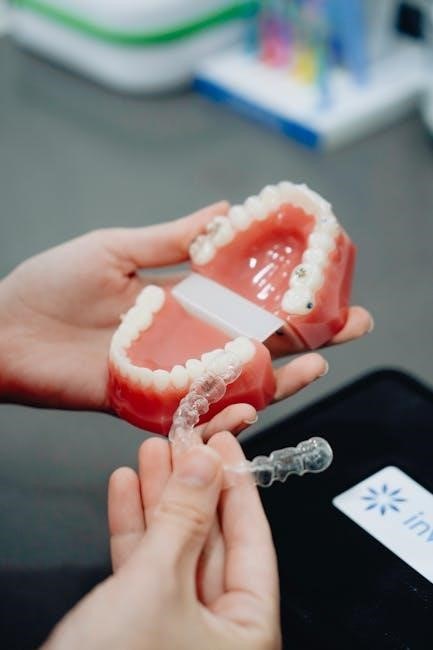Proper Invisalign care is essential for effective treatment and maintaining oral health. This guide provides detailed instructions on wear schedules, cleaning, storage, and avoiding common mistakes to ensure optimal results.
Understanding the Importance of Proper Invisalign Care
Proper care for Invisalign aligners is crucial for ensuring treatment effectiveness and maintaining oral health. Neglecting care can lead to damaged aligners, poor hygiene, or delayed results. By following guidelines, patients can prevent issues like bacteria buildup or misaligned teeth. Proper care also ensures aligners remain comfortable and invisible, fostering confidence during treatment. Adhering to care instructions is essential for achieving the best outcomes and protecting your investment in a straighter, healthier smile.
Daily Wear Schedule for Invisalign Aligners
Wear your Invisalign aligners for 20-22 hours daily, removing them only when eating, drinking, brushing, or flossing. Consistency ensures optimal results and aligns with your treatment plan.
Recommended Wear Time: 20-22 Hours per Day
Wearing Invisalign aligners for 20-22 hours daily is crucial for optimal results. This ensures maximum effectiveness and proper tooth movement. Remove aligners only for eating, drinking, or oral hygiene. Consistency is key to staying on track with your treatment plan. Failing to meet the recommended wear time may delay progress. By adhering to this guideline, you can achieve the desired smile transformation efficiently and effectively.
How to Insert and Remove Aligners Properly
Inserting and removing Invisalign aligners requires careful handling to avoid damage. To insert, use two hands, applying equal pressure starting from the front teeth and moving backward. Ensure the aligners are fully seated for proper fit. To remove, use your fingertips near the molars on one side, gently pulling down, then repeating on the other side. Avoid biting aligners into place, as this can cause misalignment or damage. Always handle aligners gently and rinse them with water after removal to maintain hygiene and prevent bacteria buildup.
Cleaning and Maintenance of Invisalign Aligners
Regularly clean your aligners with a soft toothbrush and mild toothpaste. Rinse thoroughly after removal to prevent bacteria buildup. Avoid harsh chemicals and use Invisalign-approved cleaning products for optimal hygiene and clarity.
Daily Cleaning Routine: Best Practices
For optimal hygiene, clean your Invisalign aligners daily using a soft-bristle toothbrush and mild toothpaste. Gently scrub all surfaces to remove plaque and bacteria. Rinse thoroughly with warm water after cleaning. Additionally, rinse your aligners every time you remove them to prevent bacteria buildup. Avoid using harsh chemicals, denture cleaners, or bleach, as they can damage the aligners. For deeper cleaning, use Invisalign-approved cleaning products once a week. Always store your aligners in their case when not in use to keep them clean and protected.
Using Invisalign Cleaning Products Effectively
To keep your aligners clean and hygienic, use Invisalign cleaning products as directed. Soak your aligners in the cleaning solution for 15-30 minutes, then rinse thoroughly with warm water. These products are specifically designed to remove bacteria and plaque without damaging the aligners. For a deeper clean, gently brush your aligners with a soft toothbrush and mild toothpaste before soaking. Avoid using abrasive cleaners or bleach, as they can harm the material. Regular use of these products ensures your aligners stay clear and odor-free.
What Not to Use: Avoiding Harsh Chemicals
Never use denture cleaners, bleach, or abrasive products to clean your Invisalign aligners, as they can damage the material or discolor it. Avoid soaking aligners in mouthwash or boiling water, as this can warp or degrade them. Instead, use a soft-bristle toothbrush with mild soap and lukewarm water for gentle cleaning. Harsh chemicals can compromise the aligners’ integrity and effectiveness, so stick to recommended cleaning methods to maintain their clarity and functionality throughout your treatment.

Storage and Handling of Aligners
Always store your Invisalign aligners in their provided case to protect them from damage or loss. Keep them away from pets and handle gently to avoid bending or warping.
Using the Invisalign Case: Keep Them Safe
Store your Invisalign aligners in their official case when not in use to prevent loss or damage. Keep the case in a safe, dry place away from pets. Always open the case carefully to avoid bending the aligners. Never store them in napkins or tissues, as this can lead to accidental disposal. Cleaning the case regularly with mild soap and water is recommended to maintain hygiene. This ensures your aligners remain safe and effective throughout your treatment.

Oral Hygiene Practices with Invisalign
Brush and floss thoroughly before reinserting aligners to maintain cleanliness and prevent bacteria buildup. Proper oral hygiene ensures healthy teeth and gums during treatment.
Brushing and Flossing Before Reinserting Aligners
Brushing and flossing your teeth thoroughly before reinserting your aligners is crucial to remove food particles and plaque, ensuring a clean environment for your aligners. Use fluoride toothpaste and a soft-bristle toothbrush to gently clean all surfaces of your teeth. Flossing helps remove trapped food between teeth, preventing bacteria buildup. Avoid using abrasive products that could damage your teeth or aligners. Proper oral hygiene not only maintains the clarity of your aligners but also supports overall dental health during treatment.
Importance of Maintaining Good Oral Hygiene
Maintaining good oral hygiene is crucial during Invisalign treatment. Aligners can trap bacteria, leading to bad breath and tooth decay if not properly managed. Regular brushing and flossing remove plaque and food particles, ensuring your teeth stay healthy and your aligners fit snugly. Clean teeth also help prevent stains on the aligners, keeping them clear and discreet. Neglecting oral hygiene can result in complications, potentially extending treatment time. Prioritize your dental health to achieve the best outcomes with your Invisalign journey.
Handling Aligners Gently to Avoid Damage
Always handle your Invisalign aligners with care to prevent damage. Use two hands when inserting or removing them to avoid bending or warping. Never bite or force aligners into place, as this can crack or break them. Avoid exposing aligners to extreme temperatures or harsh chemicals, which may degrade the material. Store them in the provided case when not in use to protect from accidental damage or loss. Handle only one aligner at a time to minimize the risk of scratches or damage.

Common Mistakes to Avoid with Invisalign
Avoid placing aligners in harmful locations, such as napkins or pockets, to prevent accidental disposal or damage. Keep aligners away from pets, as they may chew them.
Don’t Place Aligners in Harmful Locations
Placing aligners in harmful locations, such as napkins, pockets, or near pets, can lead to accidental damage, loss, or contamination. Avoid wrapping them in tissues or leaving them in areas where they may be discarded or chewed by pets. Always store aligners in their designated case when not in use to ensure safety and longevity. Proper handling and storage are crucial to maintaining the integrity of your Invisalign aligners and achieving successful treatment outcomes.
Avoiding Damage from Pets or Accidental Disposal
Pets often view aligners as chew toys, which can cause irreversible damage. Keep aligners out of reach of pets to prevent chewing or destruction. Additionally, avoid placing aligners in napkins, pockets, or other risky locations where they may be accidentally discarded. Always use the provided case for storage to prevent loss or damage. By taking these precautions, you can protect your aligners from unintended harm and ensure uninterrupted treatment progress.
Dealing with Discomfort or Soreness
Mild soreness is common when starting new aligners, indicating teeth movement. This discomfort typically subsides within a few days. Over-the-counter pain relievers can help manage it.
Normal Soreness After New Aligner Stages
It’s common to experience mild soreness when starting a new set of aligners, as they apply pressure to move your teeth. This discomfort usually subsides within a few days. Patients can manage this by taking over-the-counter pain relievers or chewing on a cold compress wrapped in cloth. If soreness persists or worsens, contact your orthodontist for guidance. Remember, this temporary discomfort is a sign that your aligners are working effectively to straighten your teeth.
Temporary Speech Changes: What to Expect
Some patients may notice temporary speech changes, such as a slight lisp, when first using Invisalign aligners. This is due to the aligners affecting tongue placement and mouth movement. Speech typically returns to normal as the mouth adjusts. To adapt, practice speaking with the aligners in place or chew slowly to help your mouth grow accustomed to them. Most patients find their speech improves within a few days of consistent wear.

Monitoring Progress and Compliance
Track your wear time to ensure 20-22 hours of daily use for optimal results. Regular follow-ups with your orthodontist confirm treatment progress and address any concerns.
Tracking Wear Time for Optimal Results
Monitoring your Invisalign wear time is crucial for achieving desired outcomes. Aim for 20-22 hours daily, removing aligners only for eating, drinking, or oral hygiene. Use a timer or app to track compliance, ensuring consistent use. Regular check-ins with your orthodontist confirm progress and address any issues. Proper tracking helps maintain treatment momentum and ensures teeth move as planned. Stay disciplined to avoid delays and achieve the best possible results from your Invisalign treatment.
Follow-Up Appointments: Ensuring Treatment Success
Regular follow-up appointments with your orthodontist are vital to monitor progress and ensure your Invisalign treatment stays on track. During these visits, your orthodontist will check aligner fit, assess tooth movement, and address any concerns. They may also provide new aligners or make necessary adjustments. These appointments help prevent delays and ensure your treatment progresses smoothly. Consistent check-ups are key to achieving the desired results and maintaining the effectiveness of your Invisalign journey.
Avoiding Common Pitfalls
Avoiding common mistakes ensures better treatment outcomes. Never use harsh chemicals, denture cleaners, or bleach, as they can damage aligners. Keep them away from pets and avoid biting them into place to prevent damage and ensure proper fit.
Never Use Denture Cleaners or Soak in Bleach
Using denture cleaners or soaking aligners in bleach can damage the material, causing discoloration or weakening. These harsh chemicals are not designed for Invisalign and can compromise their effectiveness. Instead, clean your aligners gently with a soft-bristle toothbrush and water. For deeper cleaning, use Invisalign-approved products to maintain clarity and prevent harm. Avoiding such chemicals ensures your aligners remain intact and continue to work effectively throughout your treatment.
Why You Should Avoid Biting Aligners into Place
Biting your aligners into place can cause irreversible damage, such as cracks or misalignment. This improper method can lead to poor fit and reduced effectiveness of treatment. Instead, insert aligners gently using two hands and apply even pressure to ensure proper seating. Avoiding this habit helps maintain the integrity of your aligners and ensures they work as intended for your orthodontic treatment. Always handle your aligners with care to prevent unnecessary damage or delays in your progress.
Overall Care Routine
Start your day with a clean routine and handle aligners gently to maintain hygiene and ensure proper fit. Avoid harsh chemicals and store them safely in their case.
Start Your Day with a Clean Routine
Begin each morning by brushing and flossing your teeth before reinserting your aligners. Rinse your aligners with water and gently clean them with a soft toothbrush. Avoid using harsh chemicals or denture cleaners, as they can damage the material. Properly store your aligners in their case when not in use to prevent loss or damage. Consistent morning hygiene ensures a fresh start and promotes optimal treatment progress. Compliance with this routine is key to achieving your desired smile.
Rinse Aligners Every Time You Remove Them
Rinsing your aligners with water immediately after removal is crucial to remove saliva, bacteria, and food particles. This simple step prevents the buildup of harmful plaque and keeps your aligners clean. Use only water or a soft toothbrush for gentle cleaning. Avoid harsh chemicals or denture cleaners, as they can damage the aligners. Consistent rinsing ensures freshness and maintains oral hygiene, promoting a comfortable and successful treatment experience. Regular rinsing also helps prevent stains and odors, keeping your aligners clear and discreet. Make this a habit for optimal results.

Troubleshooting Common Issues
If your aligners feel loose, tight, or cause discomfort, check for proper fit and ensure you’re following wear schedules. Slight soreness is normal when starting new stages but should subside within a few days. If speech is affected, practice speaking with aligners in place. For misaligned or damaged aligners, consult your orthodontist immediately. Avoid forcing aligners into place, as this can cause breakage. Regular cleaning and proper handling are key to resolving most issues. Addressing these concerns promptly ensures smooth treatment progress.
